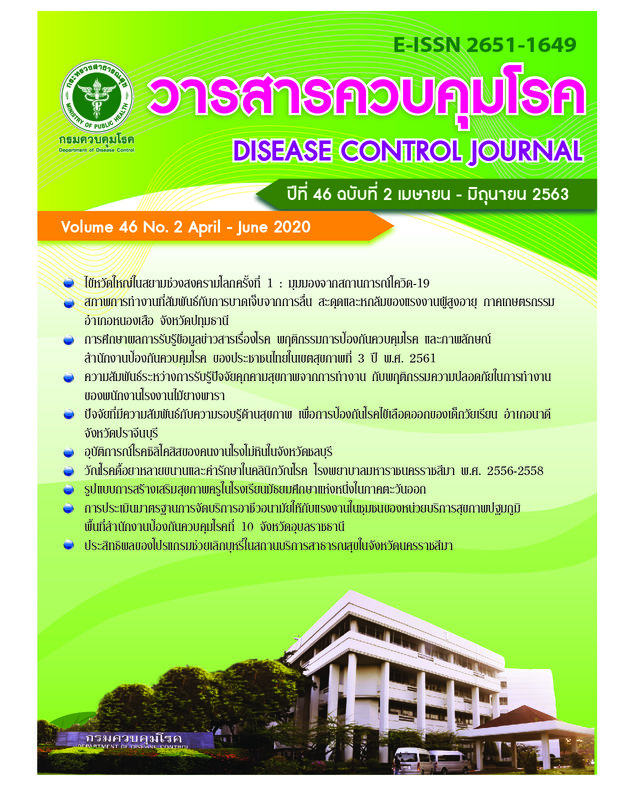Health promotion model for teachers in a secondary school in Thailand’s eastern region
DOI:
https://doi.org/10.14456/dcj.2020.18Keywords:
Health promotion, Health-related quality of life, TeachersAbstract
The purpose of this research and development was to create a model for health promotion for teachers, implement the model, and evaluate its effectiveness in a secondary school in the eastern region. The selected school was an extra-large school with 148 teachers. The research consisted of 5 steps, namely (1) study of the organization context; (2) survey of basic information including stress, self- management of diet and exercise, and health-related quality of life; (3) creation and development of the health promotion model; (4) implementation of the model; and (5) evaluation of the model effectiveness. The instruments used comprised questionnaires and focus group interviews. Data were analyzed using quantitative and qualitative methods. The results revealed that the teachers health promotion model consisted of (1) developing and implementing school health policy; (2) creating supportive environments; (3) strengthening organizational capacity for health promotion; (4) increasing teachers’ capabilities for health promotion; and (5) re-orienting health care services toward prevention of illness and promotion of health. The model was implemented for six months. The participants included 50 teachers, mostly female (96.00%), with the average age of 44 years old. The majority was married (54.00%). They had been in the career for 19.28 years (SD = 11.93), and had taught in this school for 11.10 years (SD = 9.53). Most of the teachers were senior professional level (46.00%). Forty percent had underlying health conditions. The evaluation of the effectiveness of the model indicated that the scores had changed significantly. The perceived stress score decreased, whereas the scores for self-management of diet and exercise and the health-related quality of life increased.
Downloads
References
Napao P. Quality of work life and commitment with organization of faculty and staff at private vocational education college in Bangkok. Journal of Business Administration 2013;2:64-71. (in Thai)
Tulasuk P. New govt bid to tackle teacher debt [Internet]. 2017 [cited 2019 Sep 30]. Available from: https://www.bangkokpost.com/learning/news/1245490/new-govt-bid-to-tackle-teacher-debt
Brunsting NC, Sreckovic MA, Lane KL. Special education teacher burnout: a synthesis of research from 1979 to 2013. Educ Treat Children 2014;37;681-711.
Prompinit N, Chalakbang W, Kitisriworapan P. The development of quality of life indicators of teachers under the Office of Sakon Nakhon Primary Education Service Area 2. Nakhon Phanom University Journal 2015;5:42-7. (in Thai)
Senakij K. The quality of the working life of the teachers under the Office of Secondary Education Service Area 26. Sripatum Chonburi Journal 2018;15:245-52. (in Thai)
Iemsawasdikul W. Health promotion in educational institute. Journal of Safety and Health 2018;11:1-11. (in Thai)
Health Intervention and Technology Assessment Program. What is the difference between health care and health promotion? [Internet]. 2012 [cited 2019 Sep 30]. Available from: http://www.hitap.net/17295 (in Thai)
World Health Organization. Global school health initiative [Internet]. 1995 [cited 2019 Sep 30]. Available from: https://www.who.int/school_youth_health/gshi/en
Department of Health, Ministry of Public Health. School health promotion manual. (Revised edition, 2015). Nonthaburi: Department of Health, Ministry of Public Health; 2019. (in Thai)
Kittiratchakool N, Chinnacom D, Phothihang O, Praditsitthikorn N, Teerawattananon Y, Tantivess S. An evaluation of data and report systems in the elementary school health services: a case study in two provinces of Thailand. Journal of Health Systems Research 2018;12:306-27. (in Thai)
Mongkol S, Hansuwannakorn P, Mikaphon S, Siwakritsanakun K. Effect of seven-minute exercise program on body-fat percentage in obese women. Srinagarind Med J 2019;34:75-82. (in Thai)
Subramaniam M. SWOT analysis: discover new opportunities, manage and eliminate threats" [Internet]. [cited 2018 Feb 24]. Available from: https://www.academia.edu/12919077/SWOT_Analysis_Discover_new_opportunities._Manage_and_eliminate_threats
World Health Orgainization. The Ottawa charter for health promotion [Internet]. 2005 [cited 2019 Sep 30]. Available from: https://www.who.int/healthpromotion/conferences/previous/ottawa/en/
Pattanaphesaj J. Health-related quality of life measure (EQ-5D-5L): measurement property testing and its preference-based score in Thai population [dissertation]. Bangkok: Mahidol University; 2014. 180 p. (in Thai)
Chanchorn W. A study of oral health promotion integration in primary school Song District, Phrae Province. J Prapokklao Hosp Clin Med Educat Center 2017;34:237-46. (in Thai)
Maksampan P. The style of cooperative management to promote the best of health of the students of Paidampittayakom Ratchamangkalapisek School. Lampang Rajabhat University Journal 2015;4:1-15. (in Thai)
Varoonchotikul S, Srisornkompon P. Purchasing guide of workout outfit for walking running exercise persons in Bangkok Metropolis. Journal of Marketing and Management 2018;4:105-16. (in Thai)
Nabkasorn C, Daewisaret W, Denan A. Effects of exercise program on depression and cortisol hormone in female adolescents with depressive symptoms. Journal of the Royal Thai Army Nurses 2018;19 (Supplement):248-58. (in Thai)
Kawela S, Kengganpanich M, Kengganpanich T, Benjakul S. Exercise behavior among employees of industries in Bangkok. Journal of Health Education 2013;36:81-93. (in Thai)
Nabkasorn C, Miyai N, Sootmongkol A, Junprasert S, Yamamoto H, Arita M, et al. Effects of physical exercise on deperession neuroendocrine stress hormones and physiological fitness in adolescent females with depressive symptoms. Eur J Public Health 2006;16:179-84.
Nitirat P, Pisaipan P, Rongmuang D, Lekwong S. Effects of mixed-theory based model for behavioral modification on the perception toward self-efficacy in self-management and the reduction of chronic disease risks among professional and non-professional staffs in Phrapokklao College of Nursing, Chanthaburi, Thailand. J Prapokklao Hosp Clin Med Educat Center 2018;35:18-29. (in Thai)
Downloads
Published
How to Cite
Issue
Section
License
Articles published in the Disease Control Journal are considered as academic work, research or analysis of the personal opinion of the authors, not the opinion of the Thailand Department of Disease Control or editorial team. The authors must be responsible for their articles.






